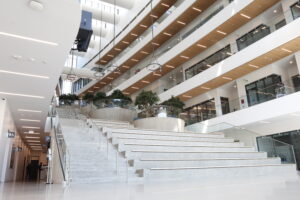[dropcap]A[/dropcap]t first glance, SFU’s libraries might look like any other silent study space. Venture a little further, though, and you will find something truly great: students helping students to achieve academic success. This is the Student Learning Commons (SLC), which is celebrating 10 years this year. While the reach of the SLC has grown quite large in recent years, the questions on many students’ minds are still: what is the SLC, and how does it help you?
Satisfying a requirement but fulfilling a need
Any SFU student today is all too familiar with the Writing, Quantitative, and Breadth (WQB) requirements, but these pesky academic must-dos haven’t always been apart of an education at SFU. In 2004, the Senate at SFU adopted the recommendations presented to them by the Undergraduate Curriculum Task Force. These recommendations led us to the WQB system. Effective September 2006, all students required these credits, along with whatever coursework is needed for their particular program, to graduate.
The current head of the SLC, Donna McGee-Thompson, gave The Peak a sense of the SLC’s trajectory, from its beginnings in 2006 to today. “At the time, there was a lot of discussion around the importance of additional support for students [. . .] after looking at various models and seeing how they would fit in the SFU context, [the task force] arrived at the SLC model,” McGee-Thompson said.
“It brings together writing, learning, and English language support into a centralized, accessible, neutral location on campus, and the library was the perfect fit for that as students already came to the library to study.”
As the need increased, the SLC began to diversify its programs. Soon, collaborations and partnerships were introduced between various departments on campus as a way of supporting students in different ways. McGee-Thompson stressed the fact that the SLC is not a “little operation run on the side,” but a broadly reaching initiative that is run by dedicated staff members and student volunteers.
The peer-to-peer model
The peer-to-peer model is a casual, low stakes way for students to get support for their writing and learning. This is the type of atmosphere that peer educator Marton Jalkoczi hopes to bring to each of his consultations. Jalkoczi, who is an international studies major, told The Peak how the SLC helped him throughout his degree.
Before going to the SLC, Jalkoczi described himself as a “shy person,” whose biggest hurdles coming out of high school from Hungary were tutorial participation and time management.
“First year wasn’t a positive experience [. . .] I felt too young to be here,” Jalkoczi said. “I would start early on assignments, but it would take me ages to read a journal article or digest lecture material.”
Enter the SLC, which Jalkoczi stumbled upon when he wanted to apply for a job. While the SLC provides help with cover letters and resumés, they did not provide support around applying for jobs. However, Jalkoczi remembered how kind the volunteers were and how they pointed him to the right resources. As he spent more time in the library to seek the SLC’s help in essay writing, Jalkoczi quickly realized that the SLC wasn’t going to do the work for him.
“I was disappointed,” Jalkoczi laughed. “In the first 10 minutes of the consultation, I found out that my paper wasn’t going to be written for me.” But as the peer educator showed Jalkoczi different resources, disappointment became empowerment.
“After the consultation ended, I ran to the computer lab to continue working on what I had learned,” Jalkoczi said. “It helped me realize that I could do things on my own.”
Currently, Jalkoczi serves as a peer educator and shares his experience with the university community, something that fellow peer Ken Ip sees as a valuable result of the SLC structure.
Ip, who is majoring in world literature, said he enjoys the social aspect of the SLC, where students can interact with each other. One of Ip’s favourite parts about the SLC is that through the sharing of knowledge, you can learn “how to teach others to build their own academic skill set.
“Being part of a structure like the SLC means that I can see the processes of sharing taking place beyond the classroom,” Ip added. The enthusiastic peer educator also encouraged other students to get involved as a peer educator so that they can work with other like-minded students as well as help others with their academic needs.
So what’s next?
As the SLC celebrates 10 years of supporting students, McGee-Thompson has high hopes for the future. With various projects and pilot programs in the works, she says that all of this is inspired by feedback from students.
“We take the feedback that we receive very seriously, finding areas where we are meeting students’ needs and where we need to adjust,” McGee-Thompson said.
Ip echoed that sentiment, encouraging students to voice any academic concerns that they may have, to see if the SLC has any resources for them. Many times, Ip said, resources are built as a result of suggestions from students.
There is a hope that more students will know about the SLC sooner rather than later: “You shouldn’t have to hit rock bottom before you come to see the SLC,” McGee-Thompson said. “Be proactive, and know that we are here to support you throughout your degree.”














